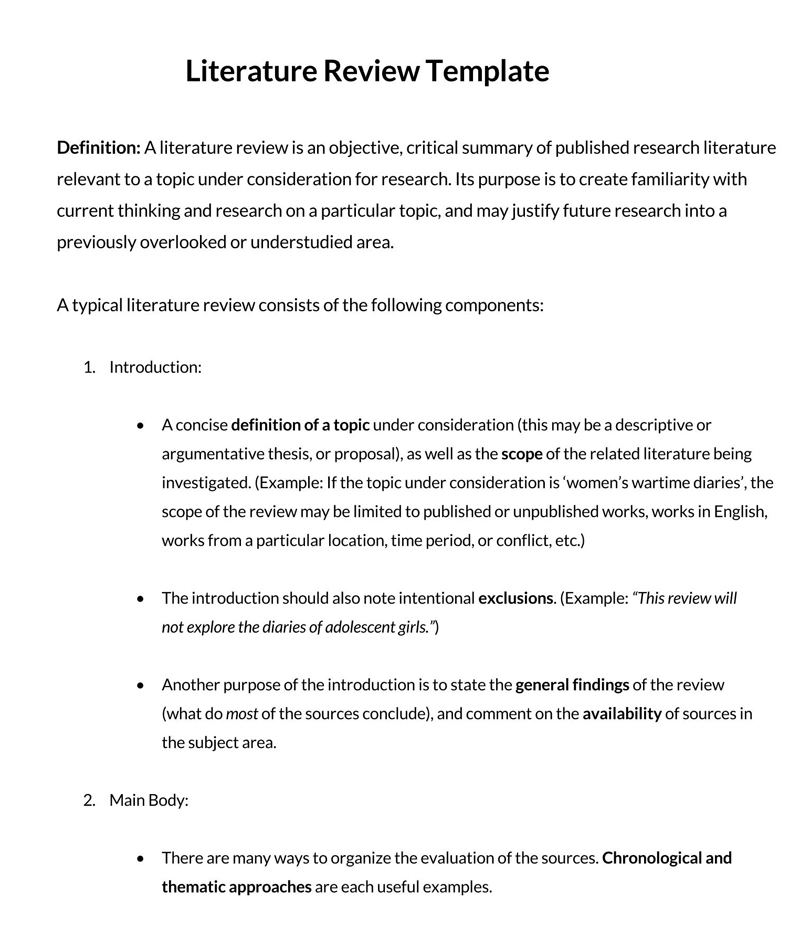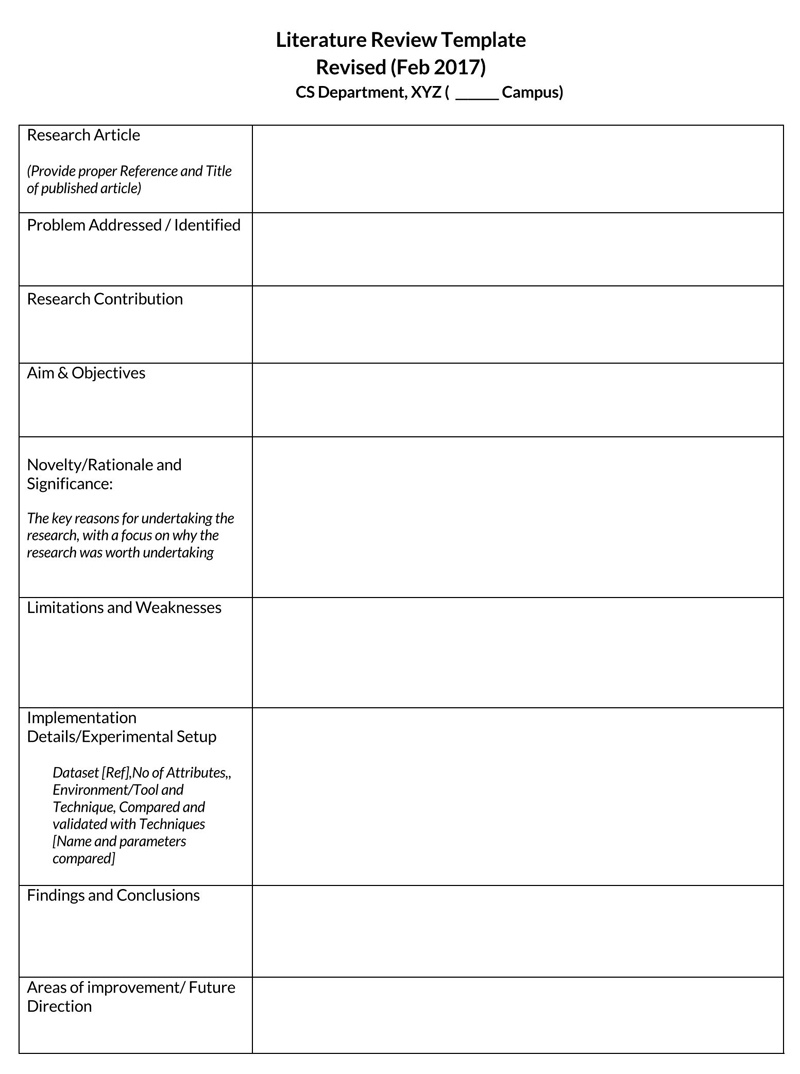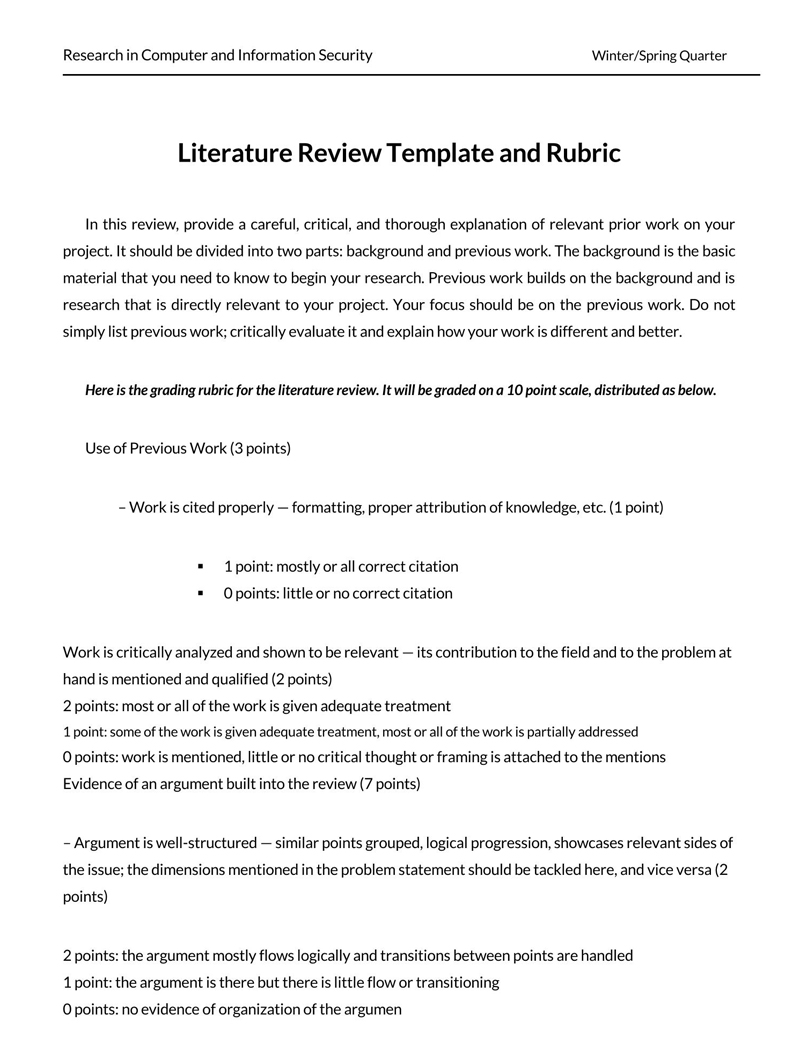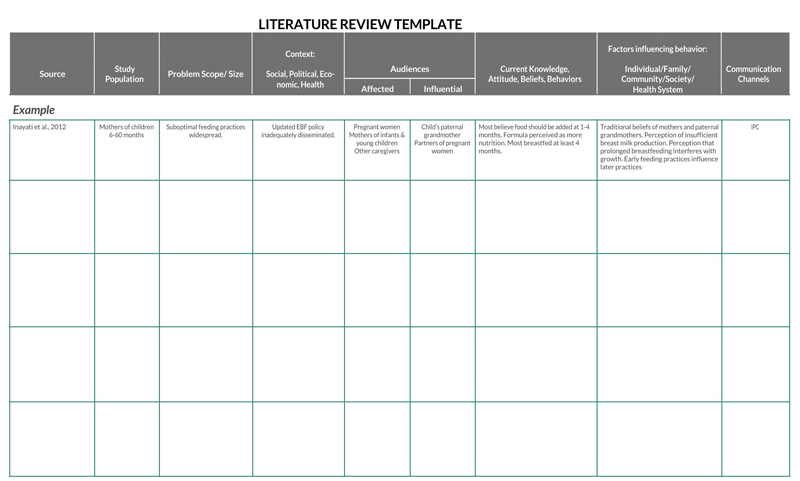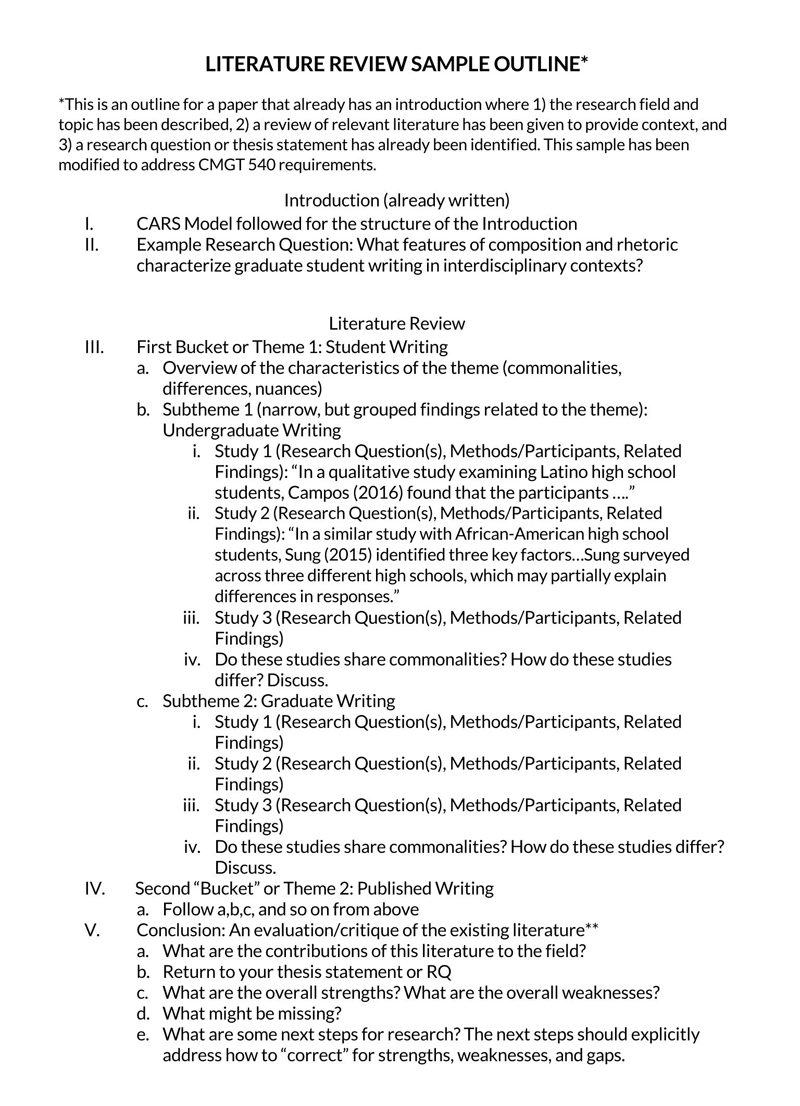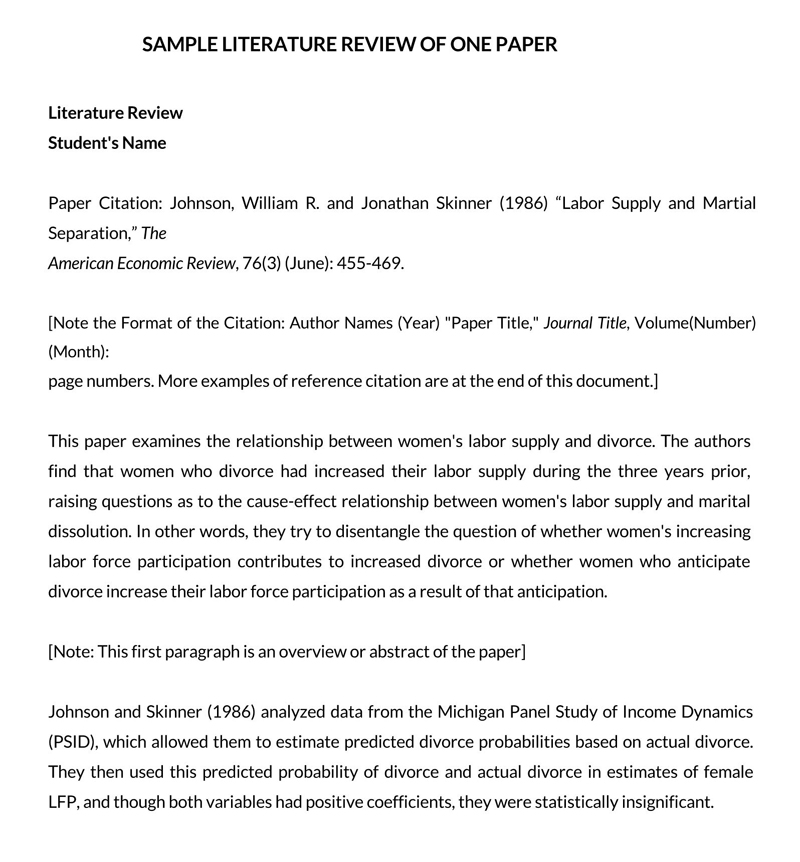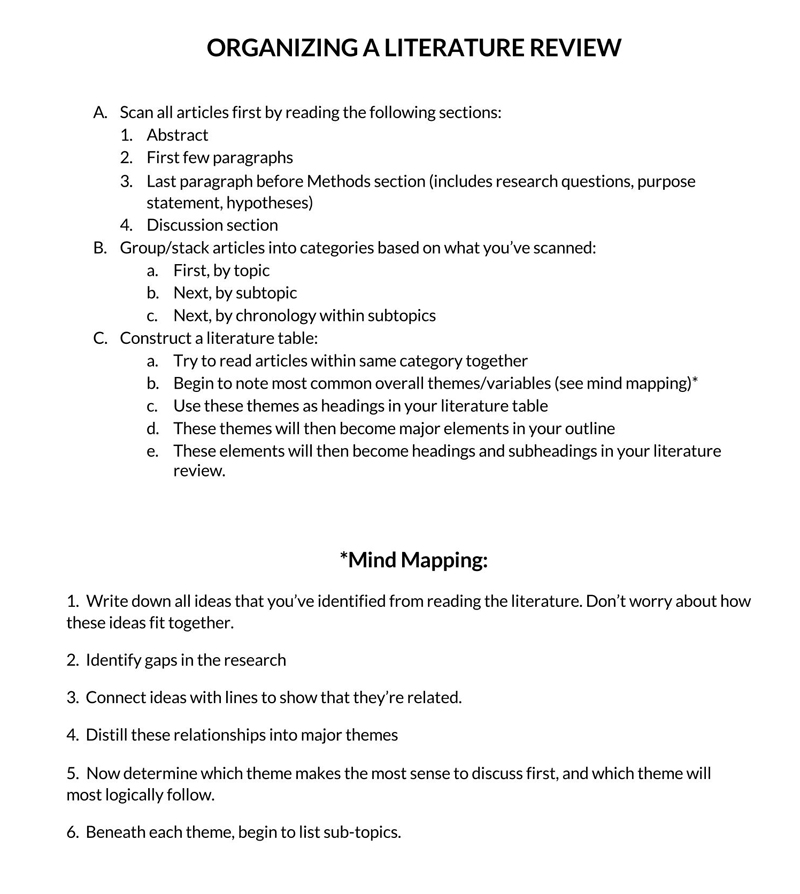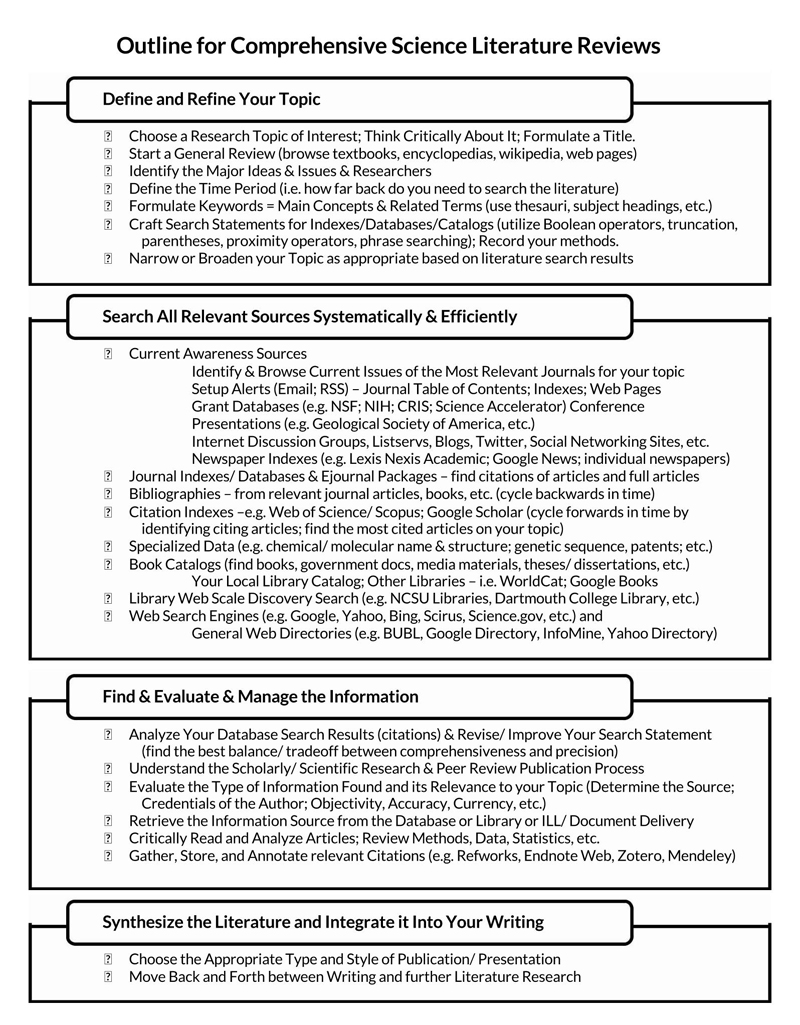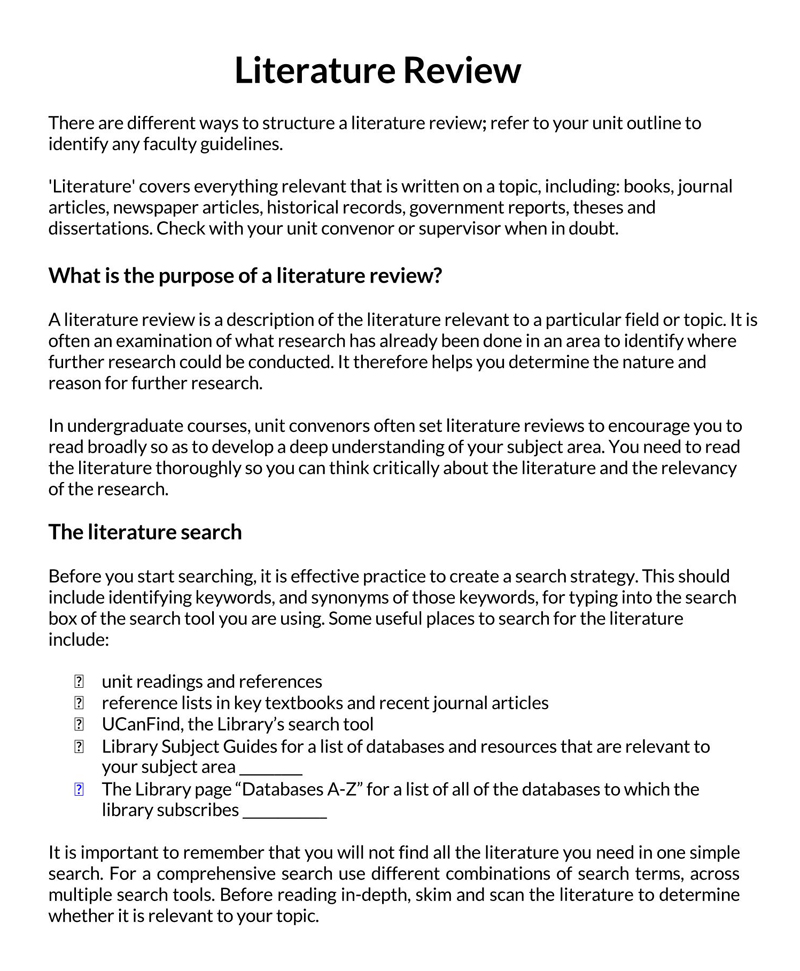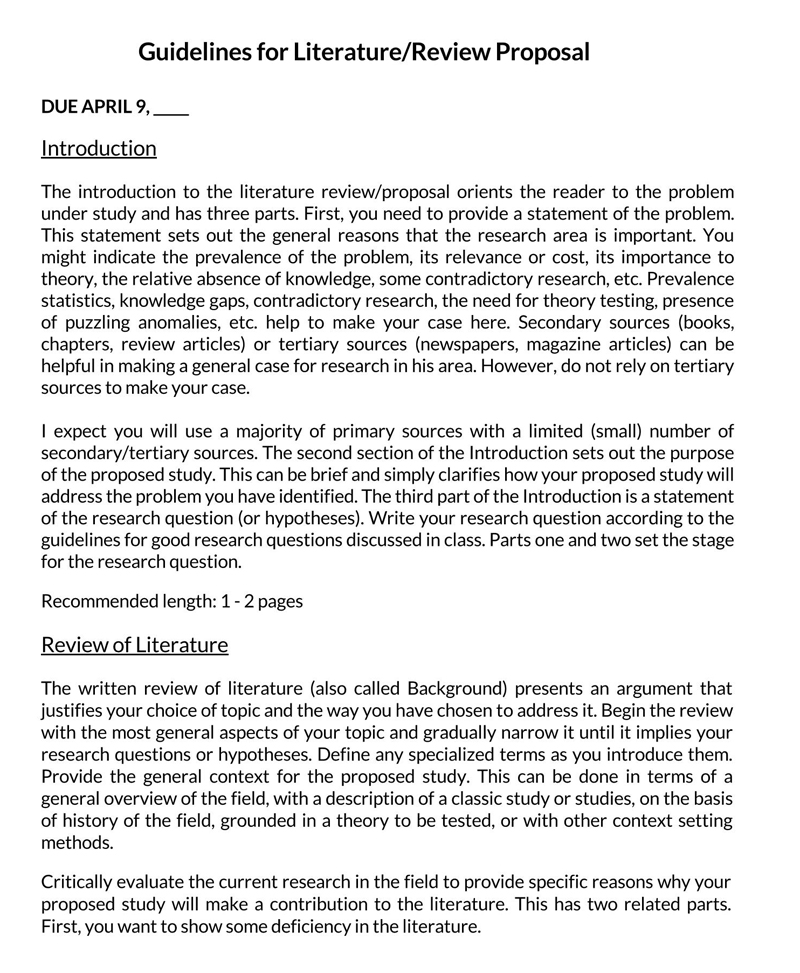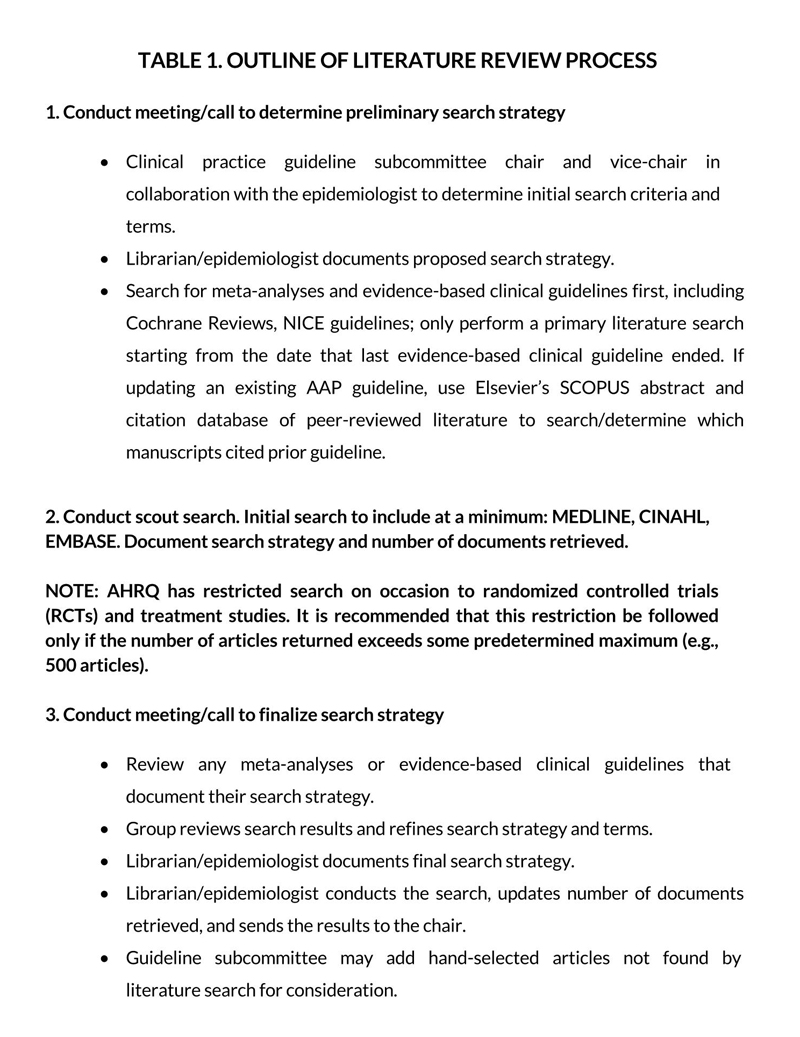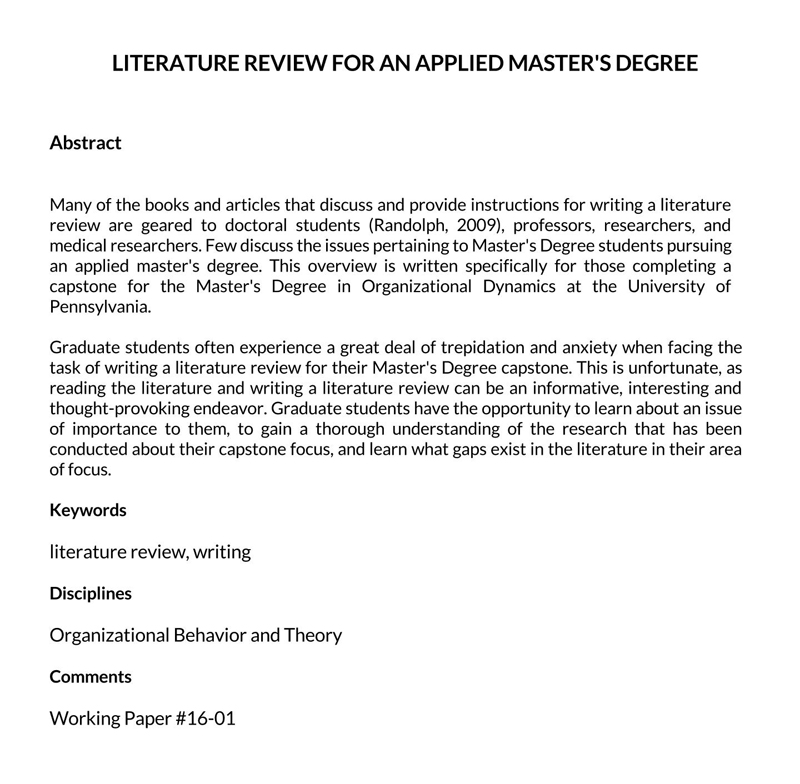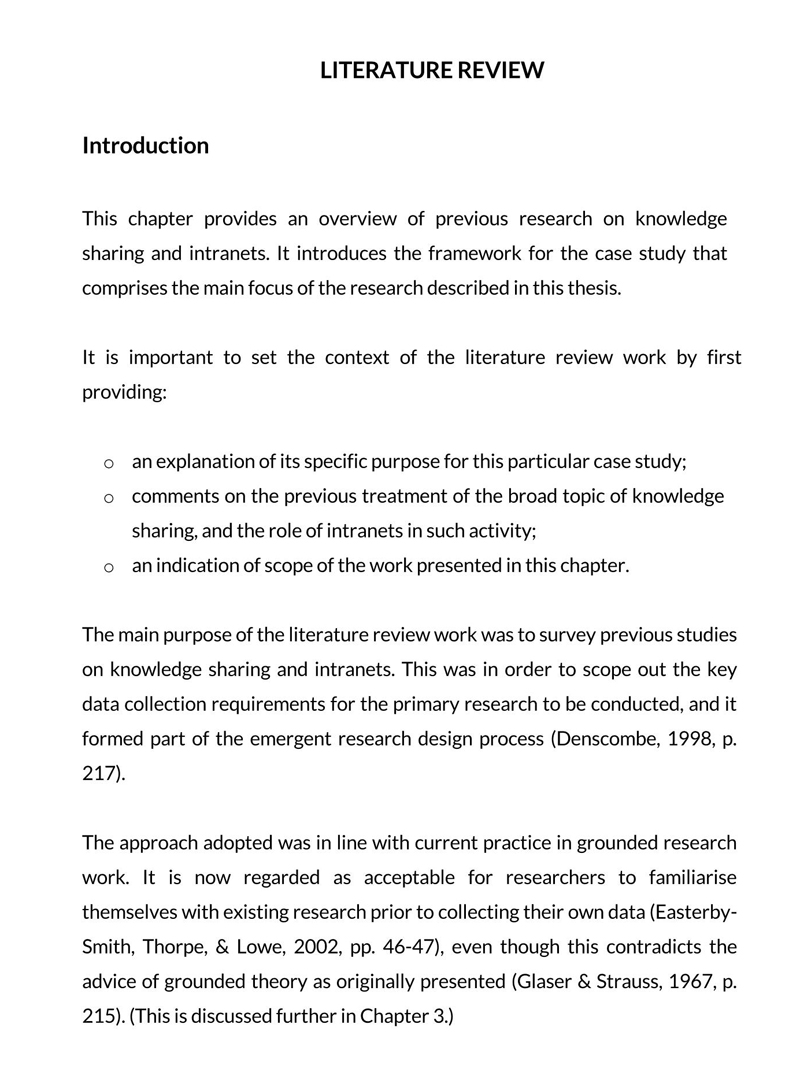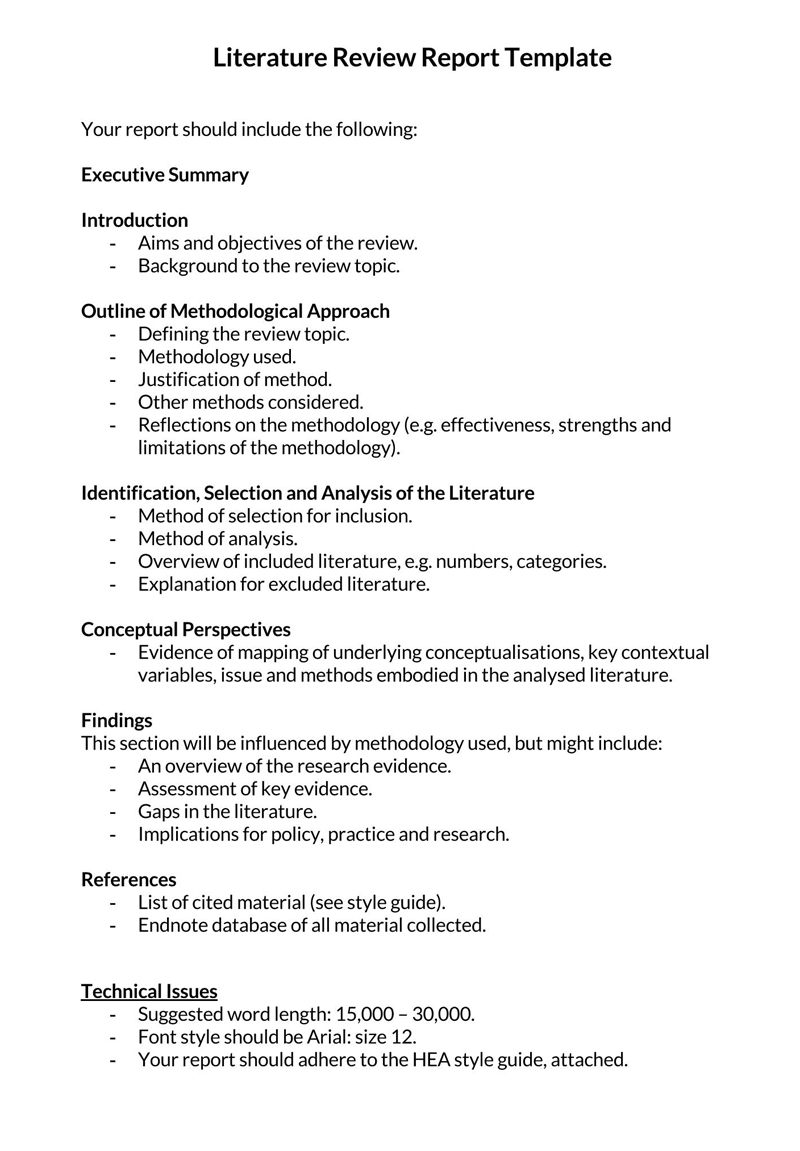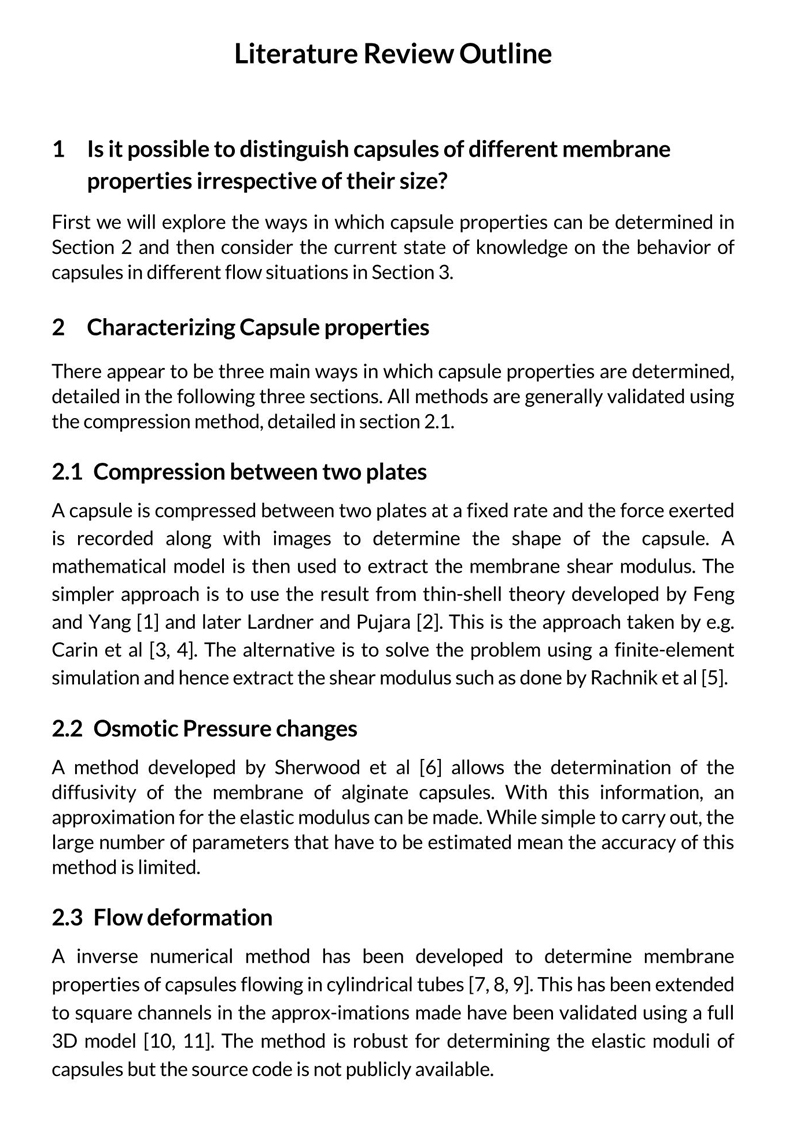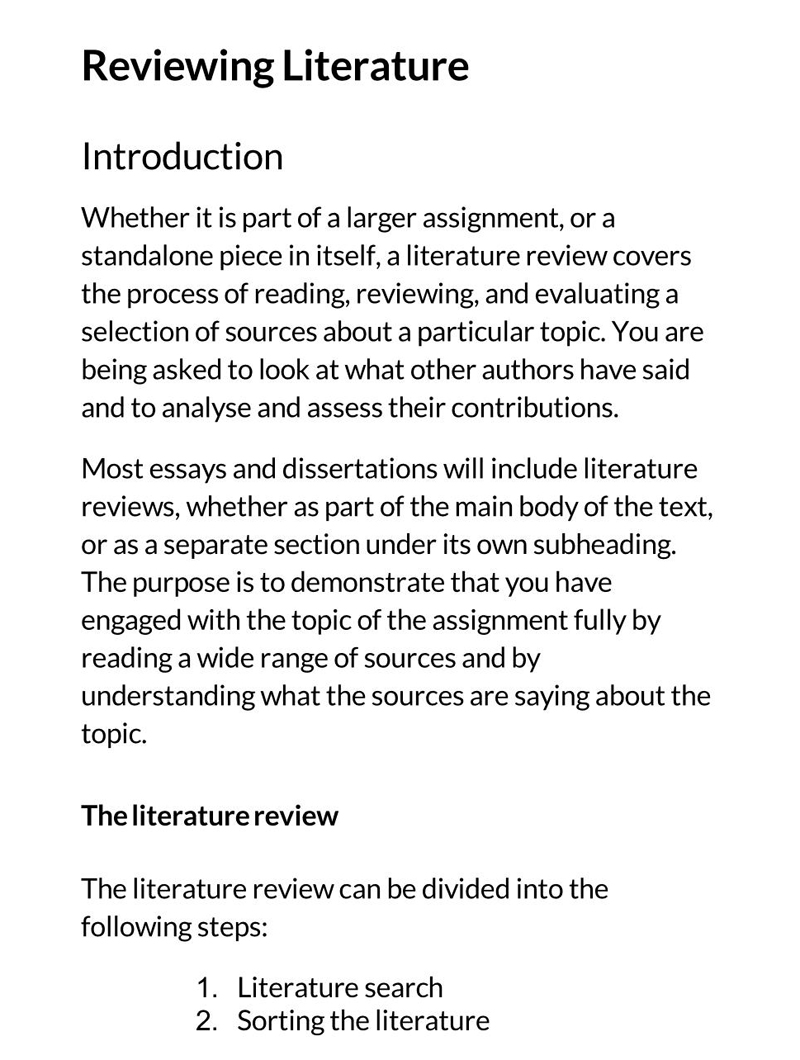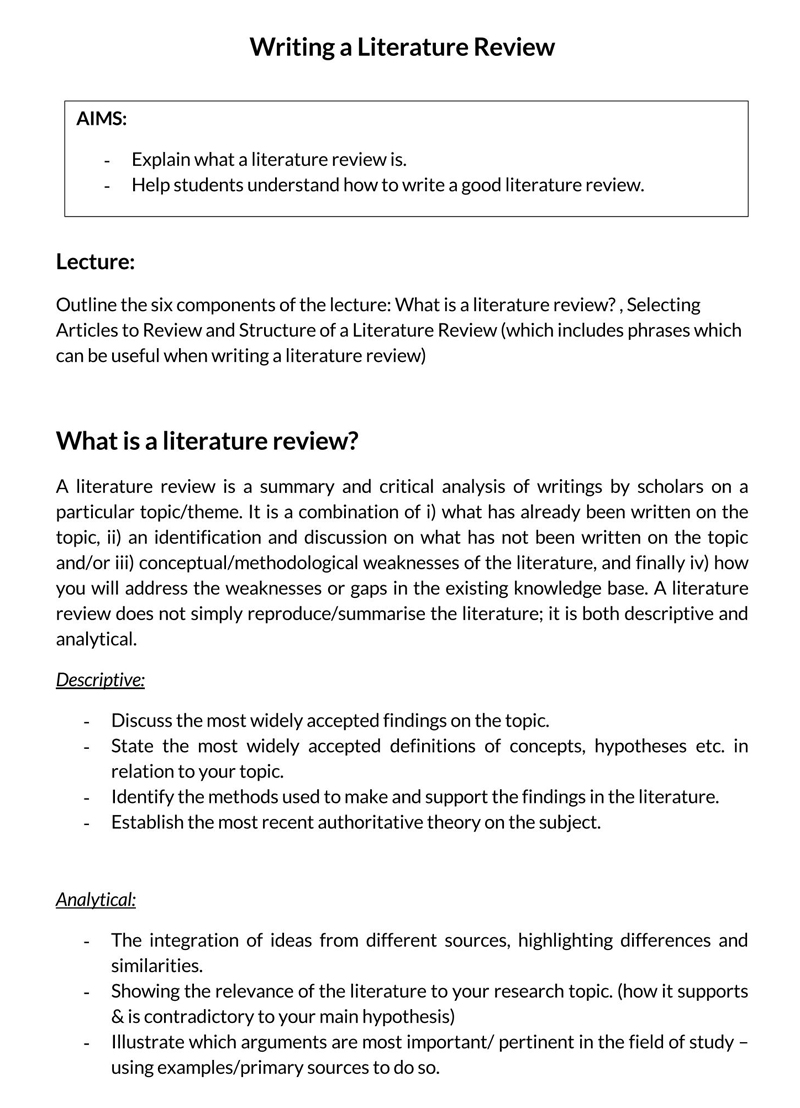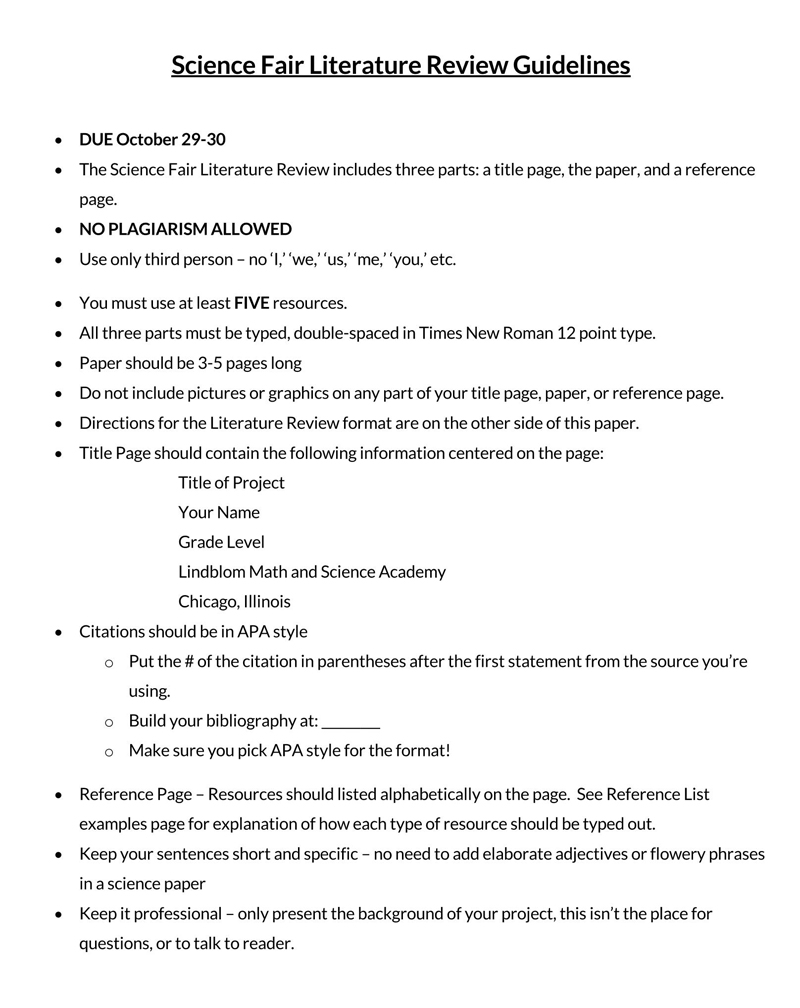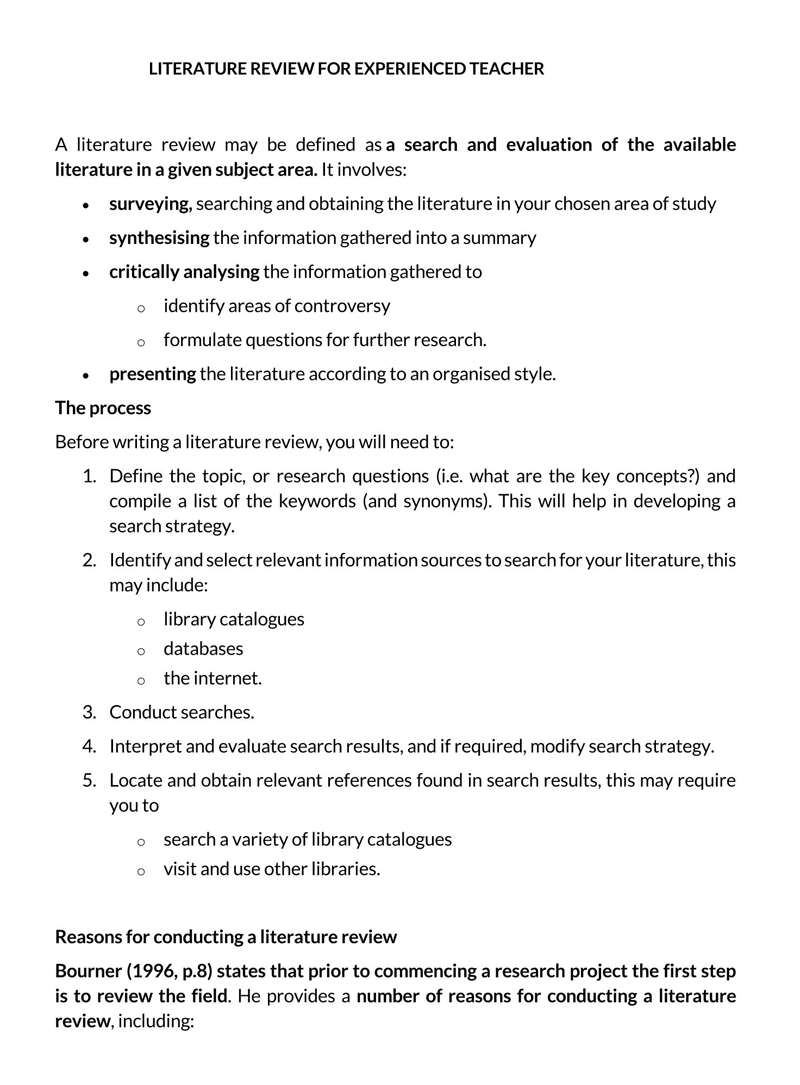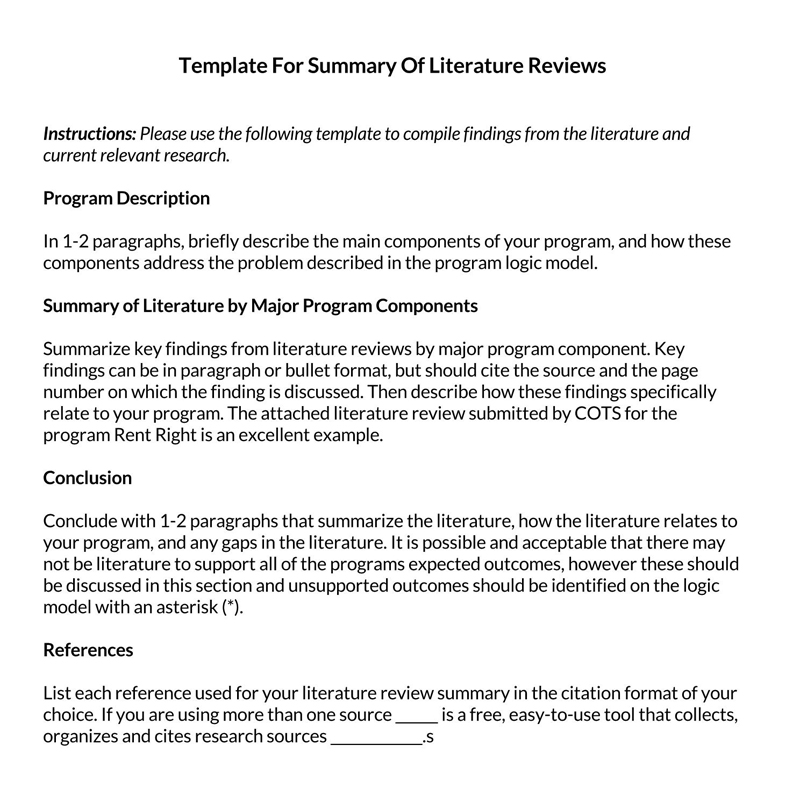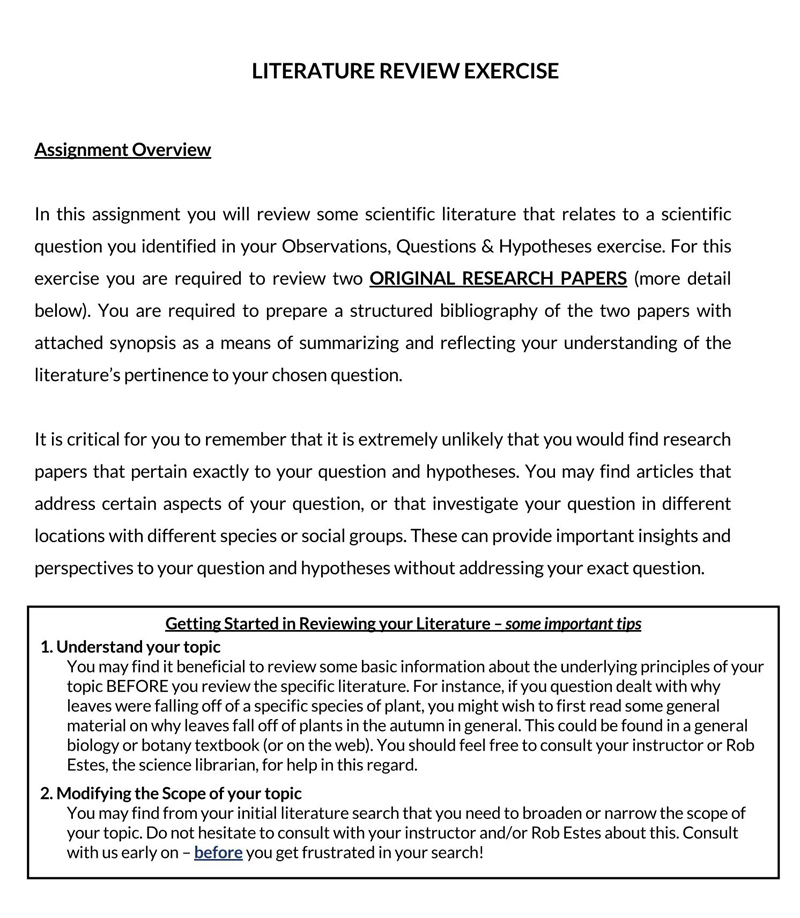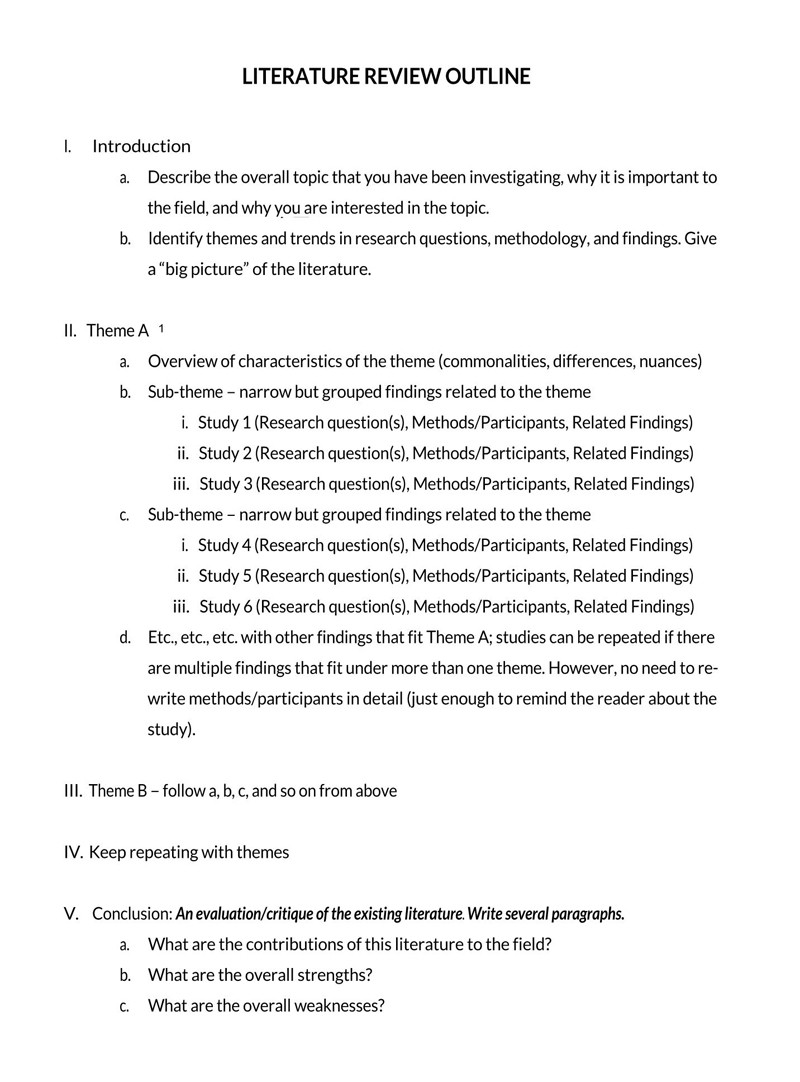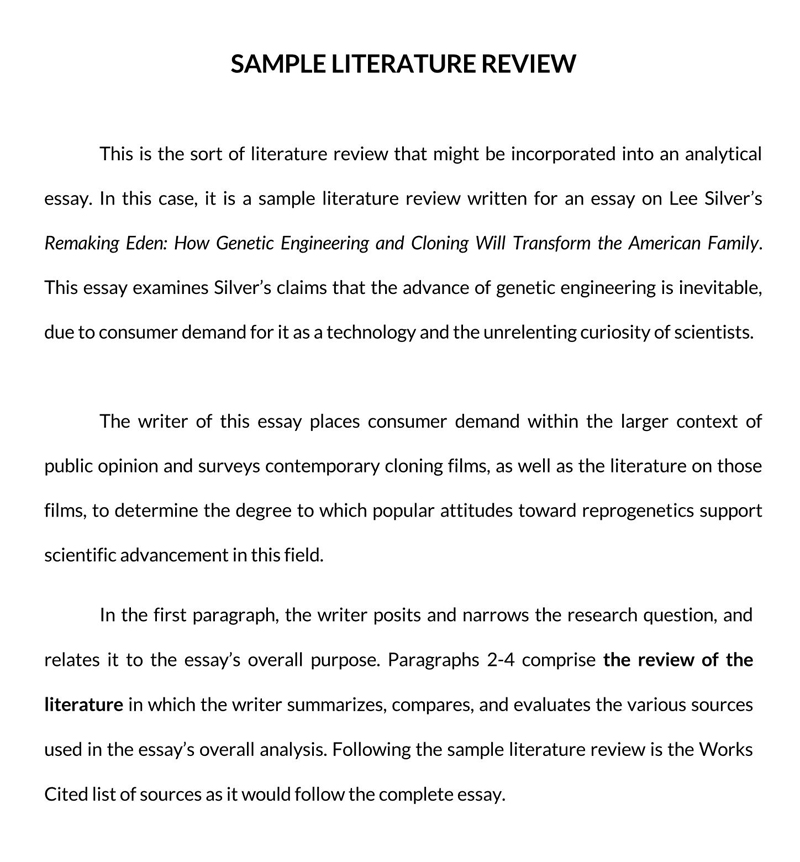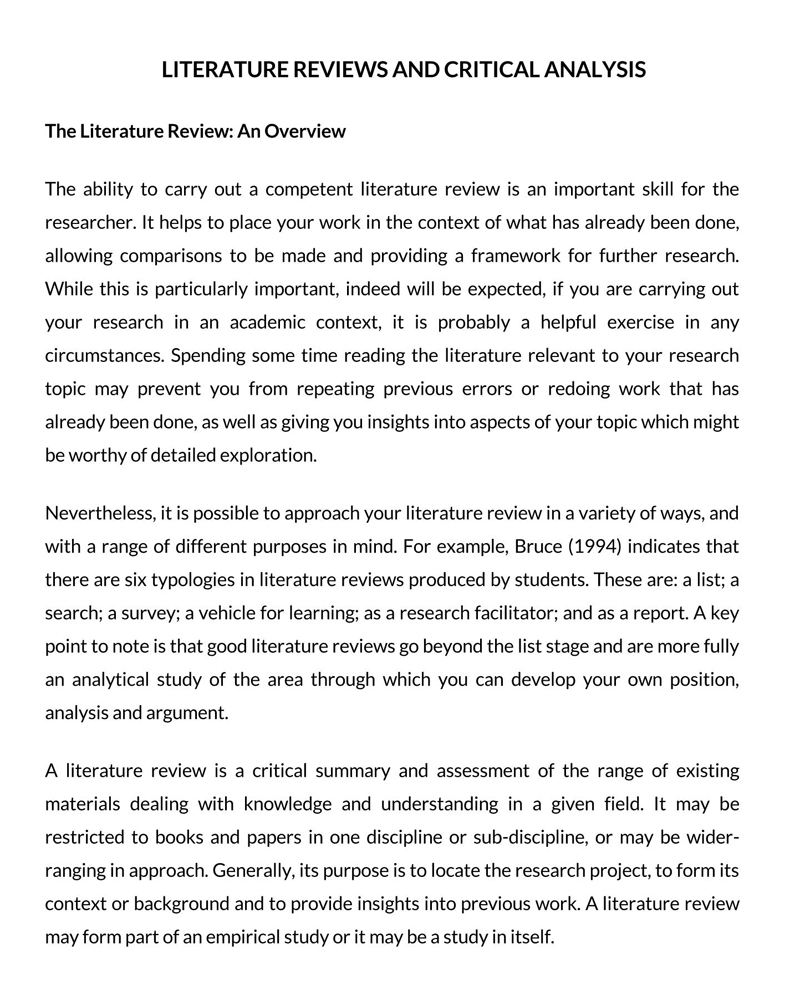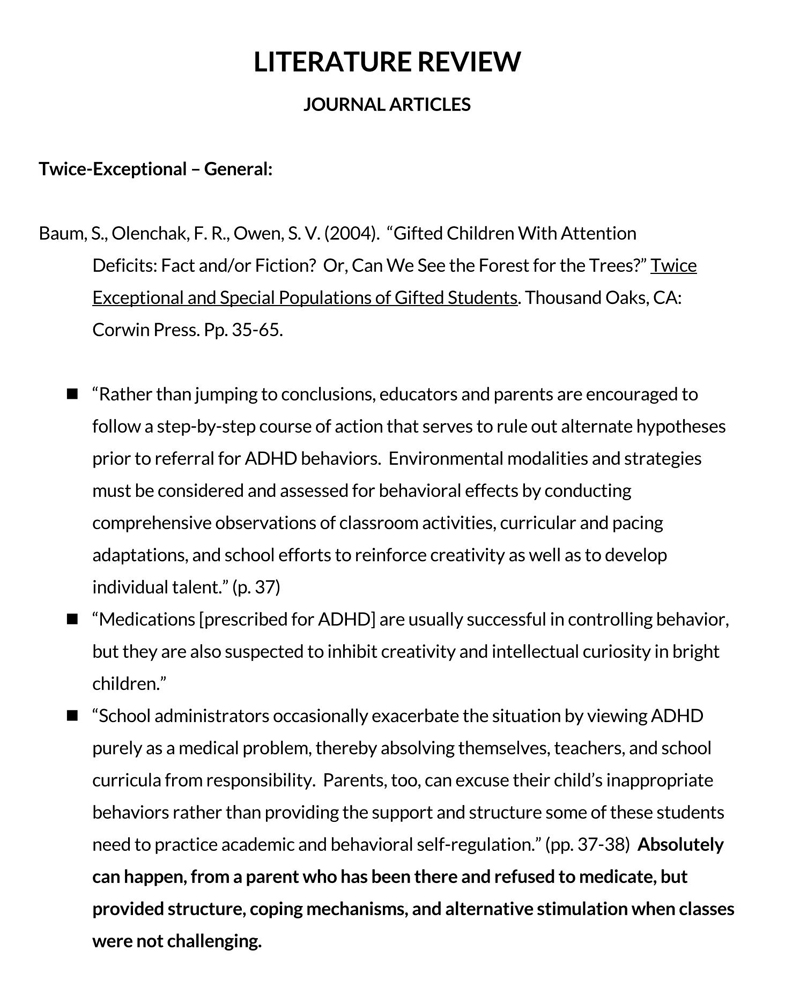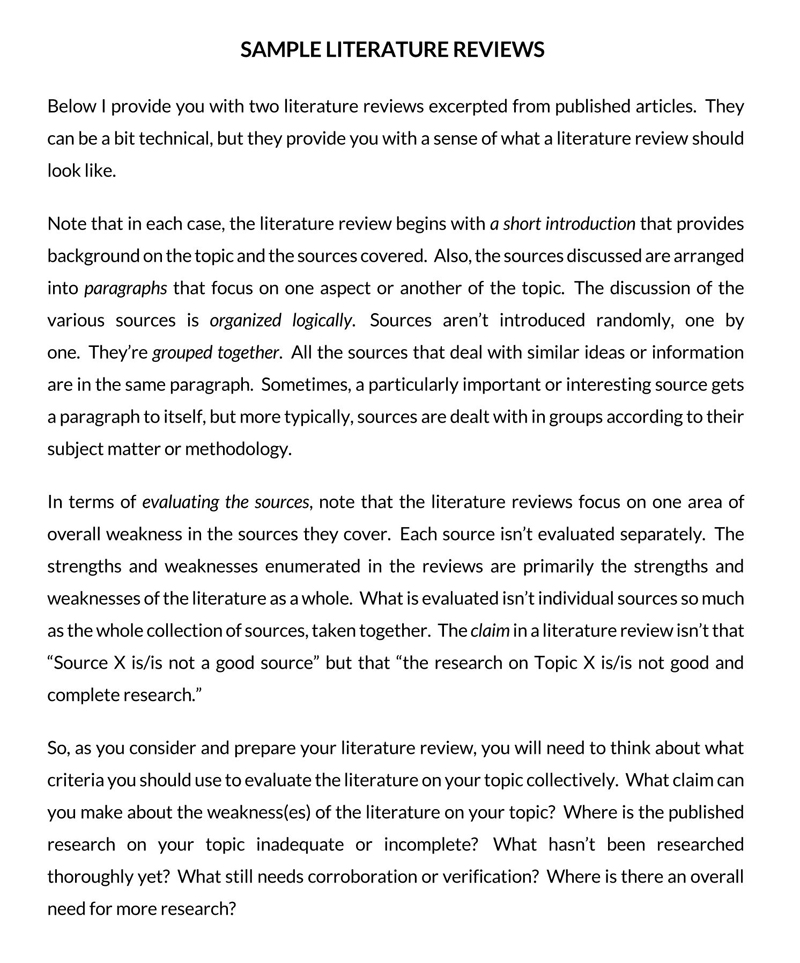A literature review is a compilation of current knowledge on a particular topic derived from the critical evaluation of different scholarly sources such as books, articles, and publications, which is then presented in an organized manner to relate to a specific research problem being investigated.
It highlights the methods, relevant theories, and gaps in existing research on a particular subject. It can be both a summary and synthesis of information on a specific topic. A summary reiterates key information from scholarly sources, while synthesis is a new interpretation or combination of new and old material.
As a synthesis, it can outline the intellectual progression of knowledge in a particular field or topic, which might involve stating key debates throughout the advancement period.
Literature Review Examples
Purpose of Literature Review
Literature reviews have different purposes in scholarly articles, research papers, and books, depending on the discipline at hand. First and foremost, reviews are generally meant to showcase the extensive research carried out by an author on a particular topic and their findings, which will form the foundation of the research. It then summarizes the information to show the author’s familiarity with the topic in question.
The review also demonstrates the relationship between the topic being investigated and other topics that were under consideration. Finally, it outlines the gaps in the previous works of other scholars, which create areas of research.
Literature reviews provide a new interpretation of previous scholarly publications and aim to resolve conflicting studies done in the past. In addition, identifying existing gaps in a particular research area illustrates the starting point of the research.
Literature Review vs. Academic Research Paper
A research paper presents new ideas, arguments, and approaches toward a particular topic. The conclusions of a research paper will be based on the analysis and interpretation of raw data collected by the author and an original study. On the other hand, a literature review is based on the findings of other publications. Thus, the review highlights the author’s understanding of a topic based on the previously conducted research. It is part of a research paper.
Where, When, and Why
The need for a literature review in a publication will vary from one situation to the other and the field/discipline of research. These two factors determine what is expected from the lit review. For example, a scientific review will be more analytical on the methods and results of previous research. In contrast, a philosophical review will be more argumentative, highlighting the discrepancies and correspondences between scholars.
It can either be part of a publication or a stand-alone document. As part of a research publication, it is often placed after the introduction to the topic outlining knowledge about a particular topic and critical sources that formed the foundation of the research. As an individual document, it is prepared by students as part of course study to aid the students in familiarizing themselves with different topics in their field of study.
Lit reviews also guide students to help them synthesize theoretical methodologies and frameworks to adopt in academic research. As a publication, literature reviews are used to document existing information about a topic for readers (other scholars) to go through for whatever reasons they may have. Published studies are essentially helpful to new scholars getting into any field of research.
Types of Literature Review
Before looking into how to write a literature review, it is vital to understand the different types. The type will usually depend on the objective approach of the author.
Common types are:
Argumentative review
An argumentative review is adopted when the research paper or publication is meant to take a contrarian viewpoint on a particular subject. The review analyses an existing argument, philosophical problem, assumption, or conclusion outlined in different studies with an objective to either support or oppose the argument.
Integrative review
An integrative review integrates secondary data to develop new perspectives and frameworks on a topic. This is more prevalent in research that does not involve primary data. In addition, integrative reviews are more familiar with social sciences.
Historical review
Historical reviews are used when scholars or authors place a particular idea, concept, theory, or research in a historical context. It examines the idea, theory, or issue from the first time it was discussed and outlines its evolution throughout a given period.
Methodological review
Methodological reviews look at how a specific theory, concept, results, or findings were developed. Therefore, methodological reviews will analyze the different methods used by different scholars to arrive at conclusions or knowledge about the topic being investigated.
EXAMPLE
Some of the methods scholars use in different disciplines to obtain information are interviewing, sampling, practical experiments/data collection, research approaches, critical thinking, social experiments, etc.
Methodological reviews are hence used to discuss tested methods of research and ethics that a researcher should be aware of before undertaking their investigations.
Systematic review
A systematic review is a more detailed and comprehensive review compared to other types of lit reviews. It highlights any existing research evidence associated with a clearly defined research problem or question. The evidence is collected, analyzed, and reported in a summarized but detailed manner. Systematic reviews are popularly presented as a cause-and-effect structure.
Theoretical review
A theoretical review delves into the different theories regarding a particular issue, challenge, concept, or theory. It identifies their inadequacy in explaining the issue or concept at hand. The review then identifies the relationships between the identified theories, and the degree of research done and poses novel hypotheses to be investigated.
Organization of a Literature Review
How an author organizes a literature review will depend on what they aim to achieve. As a consequence, there are multiple ways of organizing it which are discussed below:
Chronological
A chronological format outlines knowledge on a particular topic based on when the scholarly source of information was published. Starting with the earliest followed up to the most recent chronological order. This format should be used if there is a clear chronological order in the development of the information; therefore, it will not be applicable in some cases. Instead, key turning points, patterns, and events that impacted the direction of the knowledge should be outlined.
By publication
It can be organized in the scholarly publications reviewed by the author, scholar, or student. The by-publication format should only improve the review and facilitate what the author aims to accomplish.
By trend
Scholars or students can adopt a dominant trend in research, such as history, developmental stages, steps involved in a process, etc.
Methodological
A methodological format is based on the methods used by the researcher. Thus, the order of contents in the lit review will depend on the method they will use to carry out their research, knowledge obtained from the first method appears first, and the rest of the information follows in the same order according to the methods used by the author.
Thematic
Literature reviews organized in a thematic format revolve around the subject being investigated in no order. It is, therefore, ordinarily up to the researcher or author to determine how they intend to outline the information. A thematic format will crossover from one period and publication to another, but can sometimes incorporate a chronological order.
Theoretical
Literature reviews organized in a theoretical format have their contents organized in an abstract framework established by the author to discuss different concepts, theories, and concepts and how they relate to the research at hand.
Additional sections
Depending on the objective, other sections do not fit under conventional lit review formats that one may need to add. Below are some of the sections that authors or students can include in the lit review:
- Current situation: The review can have information about the current state of things regarding the topic at hand to facilitate further understanding.
- History: Researchers can summarize the subject under investigation, literature, or concept if the review is not already in chronological format.
- Selection methods: Lit reviews are known to outline the methods or criteria used in selecting the way to present information and scholarly sources referenced in the review.
- Standards: it can also include the standards used in choosing the format to present information in the review and the scholarly literature used in the research.
- Further questions for research: The review can include questions emanating from the review and how the researcher will further explore their research to address the queries raised.
Literature Review Samples
Considerations Before Writing a Literature Review
Preparation is essential when it comes to writing. The objective should be to come up with a review that satisfactorily explores the topic being discussed. The following considerations are steps towards that if incorporated into the writing process:
Clarify
Authors should seek clarification from mentors or supervisors before commencing the writing process. First, determine what is expected from the lit review. The type and number of sources to be used, the assignment (summarize, synthesize, or critique), and the type of information provided should be clear.
Find models
You should review literature from other authors in the same discipline and evaluate how those authors presented their lit reviews. Previous lit reviews can be used as guides that point authors in the right direction when writing their lit reviews.
Narrow your topic
It is always advantageous to narrow down the research topic to a specific area of research; that way, the number of sources can also be reduced. Even though conducting research will usually involve extensive research on all available materials about a particular topic, having a well-defined topic simplifies the task at hand.
Current sources
Determine if the research project or discipline ought to be based on the most recent findings or information. It is common for knowledge to become obsolete, especially in disciplines where discoveries and new inventions are made fast. If the lit review should be based on current knowledge, limit the sources to the most recent literature. Some disciplines will typically have a limit on how old the sources should be.
How to Write a Literature Review (Expert Guide)
Once all pre-writing considerations have been taken into account, it is time to write the document. At this point, you should already be aware of what you wish to accomplish with the literature review, and the steps to writing an exemplary lit review are mentioned below:
Problem formulation
First and foremost, clearly define the topic (research area) to be investigated. For students, this will sometimes be given as an assignment. However, the research could be an academic project, which means that the author has to come up with the problem and define it themselves.
Search for relevant studies
Once the problem is clearly expressed, you should search for studies related to the topic, concept, theory, or idea and questions surrounding the topic. Most stand-alone lit reviews will generally attempt to answer a more concentrated question. On the internet, literature can be searched using keywords related to the research area. In addition to keywords, include vital variables such as synonyms and associated terms. The inclusion of Boolean operators and, or not, is also used to narrow down results to more specific publications.
Familiar sources for publications are:
- Google Scholar
- Library catalogue
- JSTOR
- EBSCO
- Econ lit (economics)
- Project Muse (humanities and social sciences)
- Inspec (physics, engineering, and computer science)
- Medline (life sciences and biomedicine)
tip
Before selecting relevant studies, go through their abstract and determine if they fit the scope needed in the investigation. Use a list to note down any chosen works. Select landmark sources in the discipline.
Evaluation of sources/data
The next step is the evaluation stage. Evaluation involves a lot of reading. Evaluation can be done in two stages; overall skimming and thorough reading. During the second stage of this step, be critical, ask questions, and take many notes.
Some of the questions authors or researchers should ask themselves are:
- What is the author’s objective? What problem, concept, or theory are they putting across?
- What are the main concepts?
- What are the methodologies used by the author to arrive at the results and conclusions?
- What are the strengths and weaknesses of the results and conclusions?
tip
Use credible sources. Most cited sources are preferred as they indicate their influence in the field. Also, keep track of the citations to be later incorporated.
Identify themes, debates, and gaps
While reading the sources, identify key patterns, themes, debates/arguments, and gaps in each literature. These elements help tie the literature to the topic under investigation. Look for consistent patterns, themes, questions, challenges, methods, and inconsistencies in the same. Consistencies present critical information for consideration, while inconsistencies present opportunities for research areas.
Outline the structure
Formatting is part and parcel of a well-written work. Selecting the structure should start by creating an outline with all the information that will go into the lit review, then consider the different types of structures and select the most suitable. Next, take the basic structure of the introduction, body, and conclusion into consideration and start work from there.
Analysis and interpretation
Lastly, perform an in-depth analysis and interpretation of the information obtained from the scholarly research and put it into writing. The summarized, synthesized, and critically evaluated information is then written down in well-structured paragraphs that follow the chosen structure. Transition words are used to draw comparisons, connections, and contrasts.
Format
Ordinarily, a literature review will have three key components: introduction, body, and conclusion. These components should appear in the document in the following order:
Introduction
An introduction should inform the reader which topic is being studied. It gives the reader an overall idea of the purpose and focus of the document. The introduction lets the reader know beforehand the key things that will be highlighted in the document. Therefore, the introduction should be brief and precise.
Body
The next item is the body, where the primary purpose of the lit review is fulfilled. The body should take critical information from all the sources used and comprehensively present them. This is where the author reports the extensive analysis and interpretation results that they gathered from all the sources they reviewed. The body should be categorized into themes, ideas, and concepts within the main topic.
Conclusion
Lastly, a summary of what the lit review entails should be provided as a conclusion. The critical points obtained from examining the sources should be written down and linked to the primary subject of the review. Key points are those that have the most outstanding contribution to the research.
note
Studies used should be screened based on provenance (author’s credentials or credibility), methodology, objectivity, persuasiveness, and value related to the topic at hand.
Guidelines for Writing a Literature Review
To improve the delivery of information, there are certain elements that authors can incorporate. They are:
Use evidence
The lit review’s findings, interpretations, and general contents should be based on actual evidence or credible literature. Using citations is evidence of authentic information.
Be selective
There will always be a lot of information available from the reviewed sources. Authors should therefore be selective and discuss the key points that focus on the topic. Not all information must be included in the review.
Use quotes
Word-for-word quotes are acceptable. This is even more so if a critical point or author-specific terminology or knowledge cannot be paraphrased. Quotes should, however, be used sparingly.
Summarize and synthesize
The information obtained from the sources should be summarized, and the author should use it to synthesize new arguments, concepts, or ideas related to their research.
Keep your voice
The literature review should reflect the author’s voice as it is a review of other people’s works. This can be done by starting and ending the paragraphs with an original voice, ideas, and wordings.
Use caution while paraphrasing
Any paraphrased information should be conveyed accurately and in the author’s words. A citation must always be done, even when paraphrasing has been done.
Proofread
Proofread before submitting or publishing. Go through the document a few times and make the necessary changes. The review should be within the applicable guidelines. Check for language and any other errors and edit accordingly.
Do’s and Don’ts for a Literature Review
Every researcher wants to introduce their readers to a particular topic in an informative and engaging manner. Below are tips that can be used to this effect.
The following things should be opted by the researcher when writing a lit review:
- Find a focus: Authors should take a direction, idea, concept, or argument and stick to it. The information conveyed should then be made to align with the chosen point of focus. Thus, the review is not simply a list of analyzed sources, but a detailed summary of how different sources have a focal point (intertwined).
- Well-chosen sources: The quality of the information will, to a great extent, be determined by the quality of sources used. Therefore, take time to select suitable sources and more value will be added to the review.
- Create an annotated bibliography: Creating an annotated bibliography is recommended as one reads their sources. The bibliography keeps track of sources and takes notes. This information can be used when writing the final lit review.
- Synthesize research: Information obtained from the relevant studies should be combined to come up with new or original ideas. You should present a new domain based on previous sources’ knowledge, not just restating the information.
- Argumentative approach: Well-written literature reviews will often argue to support an author’s stance on a particular topic. The author can choose to address how the author’s work is filling a particular gap or support one of the scholar’s arguments and perception towards a particular topic. However, this argumentative approach will not work in all situations; it is usually discipline-specific.
- Convey it to the reader: It should let the reader know the document’s main idea, concept, or argument. This can be done by including a simple statement that compels the reader to think precisely and know what to expect.
- Break out your disciplinary box: The research will often be multi-disciplinary. Literature reviews should then collect interdisciplinary information from multiple sources as they add novel dynamics to the topic under investigation. It should be noted that this does not imply that the researcher should substitute the literature from the topic’s discipline with that from other disciplines. This is usually an improvement strategy that adds substance to the review.
- Look for repeated patterns: Be attentive to pick out repeated ideas, findings, and concepts from different scholars as they will often illustrate agreed research dead-end or a scholarly conclusion.
- Don’t just review for content: When reviewing the literature, examine the content and other writing and presentation techniques. Look out for unique ways information has been presented, methods used, consistent citations, and non-textual elements such as graphs, and figures used to present information. In addition, the researcher identifies theories used to predict, explain, or understand phenomena within the discipline.
- Search Web of Science and Google Scholar: Conduct citation tracking about the leading scholars already identified in the search process. Scholars cited by multiple scholars outside the principal discipline will generally indicate that there are no new publications on the topic.
The following don’ts should be avoided:
- Do not select studies that are not directly related to the topic being investigated.
- Avoid rushing when identifying and selecting sources to use to research the problem.
- Avoid the use of secondary analytical sources. Instead, opt to use sources with primary research studies or data. Secondary analytical sources will often cite primary analytical sources; research should refer to them instead.
- Do not accept other scholarly findings, theories, or interpretations without critically examining and critiquing them.
- Researchers should not outline the search procedures used to identify scholarly sources for reviewing purposes.
- Avoid including isolated statistical findings without illustrating how they were arrived at using chi-squared or meta-analytic methods.
- Do not review studies that only validate the assumptions, stances, and concepts of your thesis; consider contradicting works with alternative and conflicting stances.
Frequently Asked Questions
It is written by researchers, authors, and students who must study literature to gather knowledge on a particular topic they are interested in.
It should be placed right after the introduction of the dissertation. It places the research in a scholarly context by summarizing existing knowledge on the particular topic.
Researchers and authors are not limited in terms of how many sources they can review. Students will usually have a given number of sources to review as an assignment. However, the number of sources referenced in a lit review will vary from one topic or discipline to the other. Some topics have a vast catalog of available sources, while others have minimal sources, especially emerging issues. It is, however, advised that each key point discussed should have at least 2-3 references/sources. For example, a 10-page lit review will have an average of 30 references.
